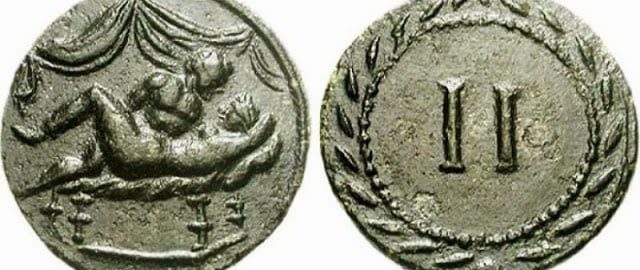Spintriae were Roman tokens (tessera) depicting erotic scenes during the early empire and probably related to prostitution in brothels. However, it is worth emphasizing that to this day their function and purpose have not been fully explained and there are various hypotheses.
The tokens were struck on bronze discs (less often copper 16-19 mm) with a diameter of approx. 20-22 mm. On one side we see the image of erotic scenes and sexual symbols. Thirteen representations of sexual positions are counted, divided into three groups: fellatio (the woman orally satisfies the man), symplegma (proper intercourse, during which the man usually holds the woman’s legs), and the moment just before intercourse. The rest are modifications of these three performances.
On the other side of the tokens, we find Roman numbers from I to XVI, often in a wreath or circular border and sometimes with the addition of dots above. There is also a separate series of spintrae with images of the busts of the family Emperor Tiberius with numbers. The tokens do not have a stamped date, we know nothing about where they were made, and they also lack a legend.
The pintriae is believed to be the same as the “lasciva nomismata” (tax paid by prostitutes) mentioned by Marcjalisa in one of the epigrams. The tokens were used to settle at the imperial cash desk and were to be the basis for calculating the tax. They come mainly from the 1st century CE (up to the times of Domitian ), although rare finds may indicate their use in the 2nd century and beyond.
The term spintria was most likely a male prostitute, traces of which can be found in Suetonius (Lives of Caesars) and Tacitus (Annals). The name was transferred to Roman obscene tokens only in the 17th century, probably due to a specific misunderstanding with the text of Suetonius. Written sources provide no evidence that it was used for objects and no other evidence. Sometimes the more appropriate and precise term Spintry tessers is used.
Hypotheses
Various hypotheses have been put forward regarding the use of these items. According to one of them, spintriae was released during the reign of Tiberius (13-37 CE) to discredit the power of the immoral emperor. Suetonius wrote about the emperor:
On retiring to Capri he devised a pleasance for his secret orgies: teams of wantons of both sexes, selected as experts in deviant intercourse and dubbed analists, copulated before him in triple unions to excite his flagging passions. Its bedrooms were furnished with the most salacious paintings and sculptures, as well as with an erotic library, in case a performer should need an illustration of what was required. Then in Capri’s woods and groves he arranged a number of nooks of venery where boys and girls got up as Pans and nymphs solicited outside bowers and grottoes: people openly called this “the old goat’s garden,” punning on the island’s name.
– Suetonius, Tiberius, 43
So the spintriae were intended to illustrate what happened on that island when the emperor settled there. The very word spintriae from Greek means “anal sphincter”, and Suetonius used this term to describe sexual practices other than generally accepted as the norm. We see draperies on the tokens in erotic scenes, which caused the presumption that they were palace interiors.
They were also seen, among others tokens (tokens) intended for a specific type of game, as well as entrance signs (brands) for public baths or for frivolous performances in street theatres. This type of hypothesis was presented already around the 17th century by Joseph Eckel in Doctrina Numorum Veterum, who was one of the first to try to explain the meaning of tokens and to assign them to specific times. He associated the appearance of spintrae with circus games organized under Diocletian, based on Marcjalis’ accounts1. It is also believed that tokens may have been collected and exchanged.
Most of all, however, they were considered tokens used in brothels (lupanars). Using them there instead of money would be dictated by the statutory prohibition of bringing coins with the image of the ruling person to places of debauchery.
The numbers displayed on the chips (often with the letter “A” added) would represent the prices for the relevant type of service expressed in assarius; the most expensive would be the denarius value (= 16 aces). It was also assumed that these numbers could denote numbers of rooms in a brothel, and even a specific position at the ratio (the letter A was combined with the word accubitio – laying).
The mysterious discs were also to be associated with the cult of fertility. It was hypothesized that the tokens were used to play as tickets to theatres, tokens symbolizing colleges. However, it should be emphasized: almost all hypotheses have understatements and there is no sure answer to what spintriae really were.









